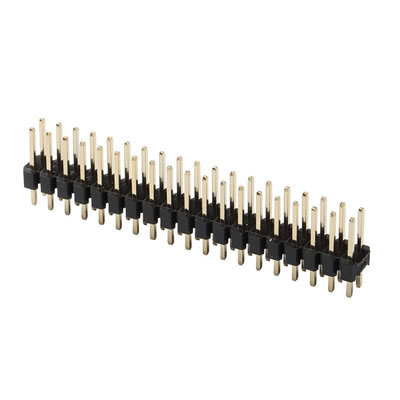Pin Header & Female Header Connector Specifications
 2025-04-14 13:23:48
2025-04-14 13:23:48

Pin Header & Female Header Connectors are one of the most common types of electronic connectors and are widely used for signal connections between PCB circuit boards. The following are some standard specifications and parameters for pin header and female header connectors, which can serve as a reference during selection, design, or procurement.
1. Structural Composition
1.1 Pin Header
·Function: Plugs into the female header to achieve electrical connection
·Common Types: Single-row, Double-row, Triple-row
·Mounting Options: Through-hole (180°), SMT, Right-angle (90°)
·Number of Rows: 1, 2, or 3 rows
·Number of Pins: e.g., 1x40, 2x20, etc.
1.2 Female Header
·Function: Mates with pin header for electrical connection
·Contact Types: Round hole, Square hole, Spring-type contacts
·Mounting Options: Same as pin headers
2. Common Specifications and Parameters
Item | Typical Values |
Pitch | 2.54mm, 2.00mm, 1.27mm, 1.00mm, etc. |
Number of Rows | Single-row, Double-row, Triple-row |
Number of Pins | Commonly 2~80 pins, customizable |
Rated Current | Typically 1A~3A |
Contact Resistance | ≤ 20mΩ |
Insulation Resistance | ≥ 1000MΩ |
Withstand Voltage | 500V AC/min |
Operating Temperature | -40℃ to +105℃ |
Plating Options | Gold plating (3μ, 6μ, 15μ), Tin plating, Nickel plating |
Component | Material |
Pin Contacts | Brass, Phosphor Bronze |
Plastic Housing | PA6T, PA9T, LCP (high-temperature resistant materials) |
Surface Plating | Gold, Nickel, or Tin plating |
Type | Characteristics |
DIP (Through-hole) | Traditional method, suitable for wave soldering |
SMT (Surface-mount) | Suitable for reflow soldering and automated placement |
Right-angle (90°) | Used for edge mounting or special spatial arrangements |
·Industrial control boards
·Consumer electronics
·Communication equipment
·Smart home devices
·Security systems
·Automotive electronics
6. Selection Guidelines
1.Clearly define the pitch and number of pins
2.Choose an appropriate mounting method (DIP/SMT)
3.Select materials based on working current and voltage
4.Consider the soldering process and packaging method
5.Ensure compatibility between pin headers and matching female headers
In conclusion, pin header and female header connectors offer high flexibility and broad applicability in structural design, electrical performance, manufacturing quality, and system compatibility. They are suitable for use in industrial control, consumer electronics, automotive electronics, communication devices, and more. Through proper selection and optimized design, these connectors can significantly enhance the overall stability and reliability of your systems.


